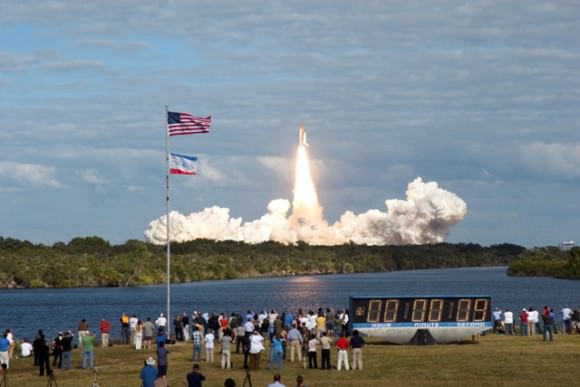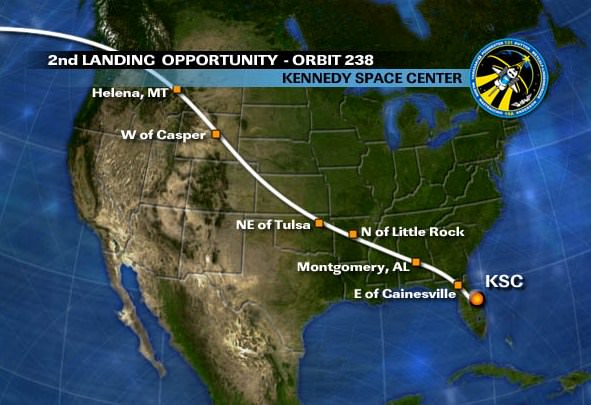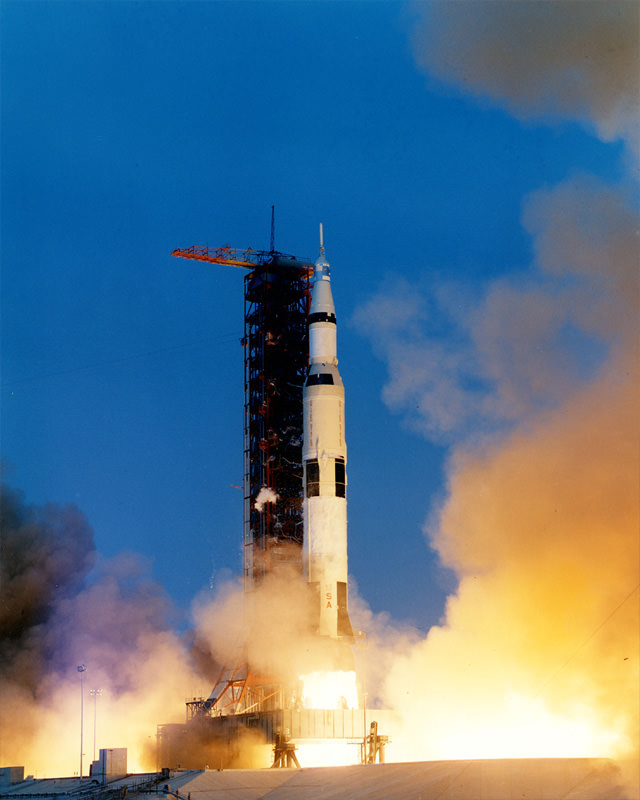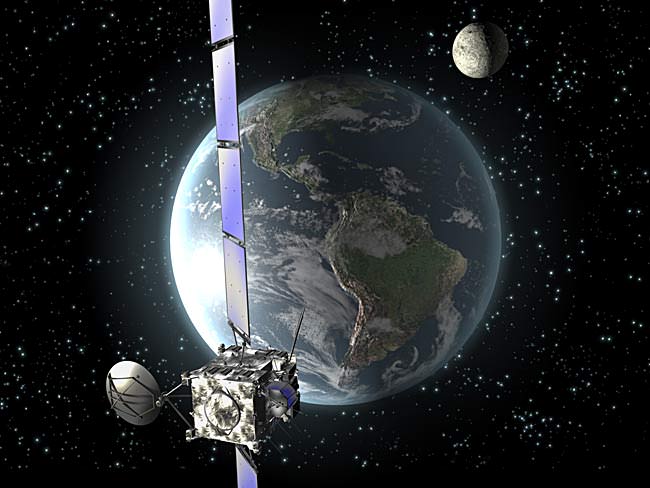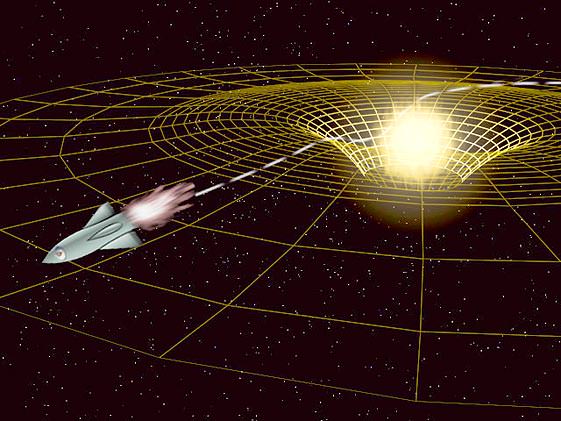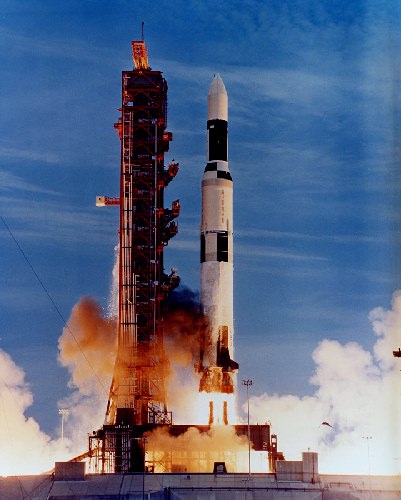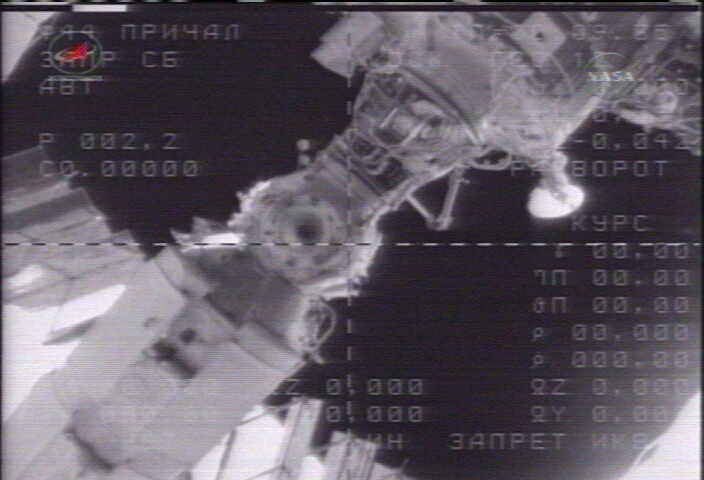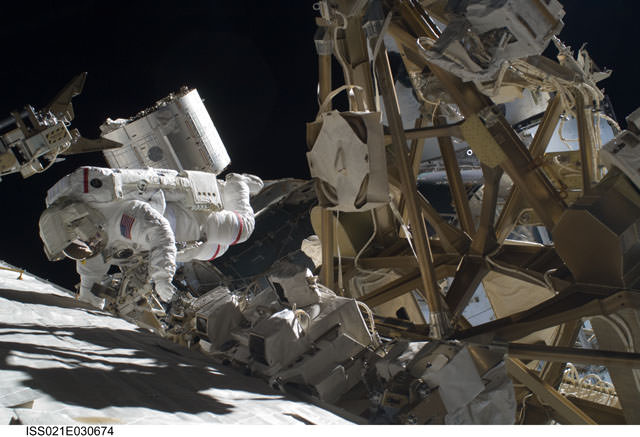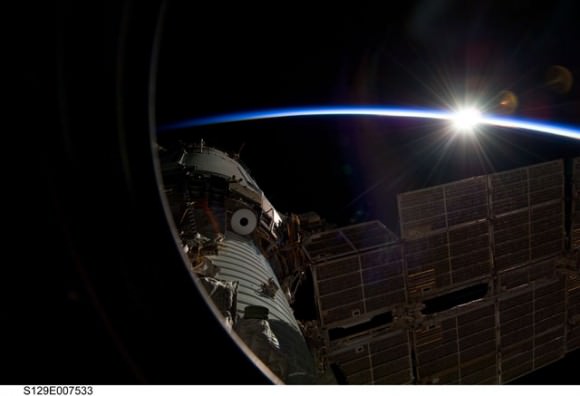Space shuttle Discovery made a cross-country trek over the US Tuesday morning, heading towards an absolutely beautiful landing at Kennedy Space Center 9:08 am EDT. Watch the great video above. (The crew at NASA TV/KSC TV really outdid themselves on this one!) If you saw Discovery soar over your hometown we want to know what it looked like! Did you capture images or video? Or can you give us a description? Send them to me and we’ll post a gallery. See below for track the shuttle took across the continental US.
[/caption]
STS-131, the Mission in Pictures
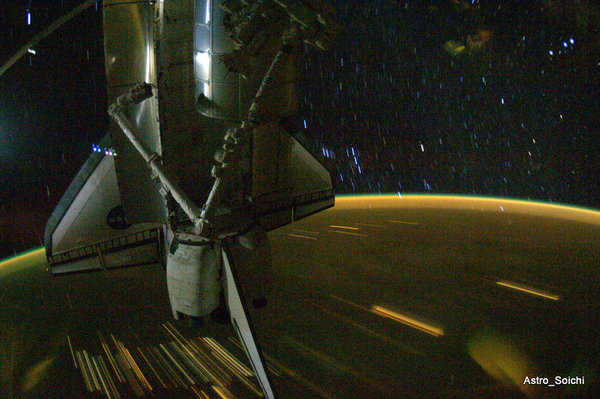
[/caption]
Space shuttle Discovery’s landing was delayed a day because of uncooperative weather at Kennedy Space Center and the crew of STS-131 will try again on Tuesday to land. But in the meantime the delay provides a great opportunity to look back at the very successful mission with a set of amazing pictures from space. This beautiful image, top, shows the station’s robotic Canadarm2 grappling the Leonardo Multi-purpose Logistics Module (MPLM) from the payload bay of the docked Discovery for relocation to a port on the Harmony node of the International Space Station. The bright sun and Earth’s horizon provide the backdrop for the scene, while the Canadian-built Dextre robot looks on. Enjoy a gallery of images, below.

Clay works outside the ISS during STS-131’s first EVA. During the six-hour, 27-minute spacewalk, Anderson and Rick Mastracchio (visible in the reflection of Anderson’s helmet visor), mission specialist, helped move a new 1,700-pound ammonia tank from space shuttle Discovery’s cargo bay to a temporary parking place on the station, retrieved an experiment from the Japanese Kibo Laboratory exposed facility and replaced a Rate Gyro Assembly on one of the truss segments.

Discovery and the International Space Station are in the midst of their rendezvous and docking activities in this image photographed by an Expedition 23 crew member aboard the ISS. Part of a docked Russian spacecraft can be seen in the foreground.

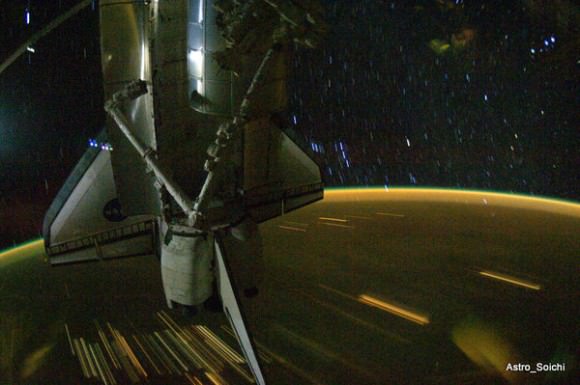
Astronaut Soichi Noguchi has taken some of the most incredible images while on the ISS. Here’s one more awesome shot of Discovery while docked to the ISS during the STS-131 mission.


Compare this image, above, of Commander Alan Poindexter and Pilot Jim Dutton in the “real” shuttle cockpit, to below, the shuttle simulator.


This mission brought together two Japanese astronauts Soichi Noguchi, Expedition 23 flight engineer; and Naoko Yamazaki (right), STS-131 mission specialist; along NASA astronaut Stephanie Wilson,

A unique view of a part of the ISS, backdropped by the blackness of space and Earth’s horizon. Visible are the Japanese Kibo complex of and a set of solar arrays. This image was photographed by an STS-131 crew member while space shuttle Discovery was docked with the station.

The microgravity environment of space provides a great place to play — experimenting with a water is always fun and it likely happens every mission!

For the first time, four women were in space together during the STS-131 mission, with three from the shuttle crew and one from the ISS. Pictured clockwise (from the lower right) are NASA astronauts Dorothy Metcalf-Lindenburger, Stephanie Wilson, both STS-131 mission specialists; and Tracy Caldwell Dyson, Expedition 23 flight engineer; along with Japan Aerospace Exploration Agency (JAXA) astronaut Naoko Yamazaki, STS-131 mission specialist.

Love this image of the STS-131 crew in the Cupola. Pictured counter-clockwise (from top left) are NASA astronauts Alan Poindexter, commander; James P. Dutton Jr., pilot; Dorothy Metcalf-Lindenburger, Rick Mastracchio, Japan Aerospace Exploration Agency (JAXA) astronaut Naoko Yamazaki, NASA astronauts Clayton Anderson and Stephanie Wilson.

Back to where the mission started, with a great time-lapse image of Discovery’s launch for STS-131. For more great launch images, see our launch gallery from Universe Today photographer Alan Walters and writer Ken Kremer, who were both at the launch.
13 Things That Saved Apollo 13, Part 3: Charlie Duke’s Measles
[/caption]
Note: To celebrate the 40th anniversary of the Apollo 13 mission, for 13 days, Universe Today will feature “13 Things That Saved Apollo 13,” discussing different turning points of the mission with NASA engineer Jerry Woodfill.
Just 72 hours before the scheduled launch of Apollo 13, Ken Mattingly was removed from the mission and replaced by Jack Swigert from the back-up crew as Command Module Pilot. Charlie Duke, also from the back-up crew caught the measles from one of his children, and exposed Mattingly — the only other member of either the prime or back-up crews who were not immune to the disease. If Mattingly were to come down with the measles, he might contract it while alone in the Command Module while Jim Lovell and Fred Haise were walking on the Moon.
“I think Charlie Duke’s measles contributed to the rescue,” said NASA engineer Jerry Woodfill, who has come up with “13 Things That Saved Apollo 13.” “This is one that probably everyone disagrees with me, but it seems like the astronauts on board were perfect to deal with what happened on the Apollo 13 mission.”
Woodfill says his conviction in no way denigrates the abilities of Ken Mattingly. “Ken was a wonderful crew member,” Woodfill said, “and he is a very detailed guy who helped with the rescue of Apollo 13 in a magnificent way. In the movie, Apollo 13, they capture the essence of how he is an ‘engineer’s engineer’.”

Although, ironically Mattingly and Duke flew together later on the Apollo 16 mission, were it not for Charlie Duke’s measles, Woodfill said that Swigert’s special talents for an Apollo 13-type mission would not have been present.
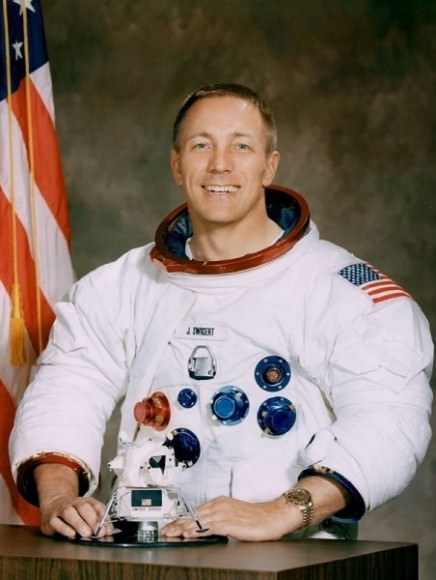
First of all, his physique was better suited to the harsh conditions he experienced in the inoperable Command Module, where he was positioned for most of the flight. Woodfill said that likely, Swigert’s brawn as a former University of Colorado varsity football player better served him to withstand the cold conditions and endure the small amounts of water that the astronauts had to ration among themselves.
Water was one of the main consumables – even more than oxygen – of which the crew barely had enough.
“Mattingly and Haise had about the same build,” said Woodfill, “which was not as robust a build as Swigert and Lovell. Haise ended up with a urinary tract infection because of not getting enough water.”
But more importantly were Swigert’s familiarity with the Command Module and his “precise” personality.
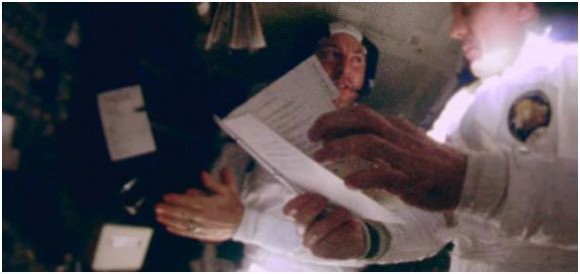
“Among the nearly thirty Apollo astronauts, Jack Swigert had the best knowledge of Command Module malfunction procedures,” said Woodfill. “Some have said that Jack had practically written the malfunction procedures for the Command Module. So, he was the most conversant astronaut for any malfunction that occurred in the CSM.”
Swigert had to quickly and accurately write down the procedure to transfer the guidance parameters from the CSM computers to the Lunar module computers. And the procedure for the reentry of the crew to Earth’s atmosphere had to be re-written, with Mission Control calling up to the crew with hundreds of changes to the original plan. “The team on the ground had to recreate a checklist and a procedural ‘cookbook’ that would normally take three months to create, and they had to do it in just days. Jack had to be accurate when he wrote down these procedures. And the communication system wasn’t always the best – it was sometimes garbled or couldn’t be heard very well. While all the astronauts had to have orderly minds, Jack Swigert was a man of extreme order.”
Woodfill said an account from Swigert’s sister bears out that fact. She at one time asked her brother Jack to put away cans of frozen orange juice and lemon juice in her freezer. When she looked in her freezer later, all the lemon juice cans were lined up in orderly fashion, with the orange juice cans neatly lined up in an adjacent row. Later, she asked her brother why he had neatly lined all the lemon cans in a row then a row of orange juice cans, and according to Woodfill, Swigert answered, “Because “L” comes before “O” in the alphabet.”
“The truth is, Swigert was gifted with a respect for extreme order and precision, and he was onboard for just that reason,” said Woodfill. “Every one of the steps in the rescue checklist had to be ‘in the right order’.”
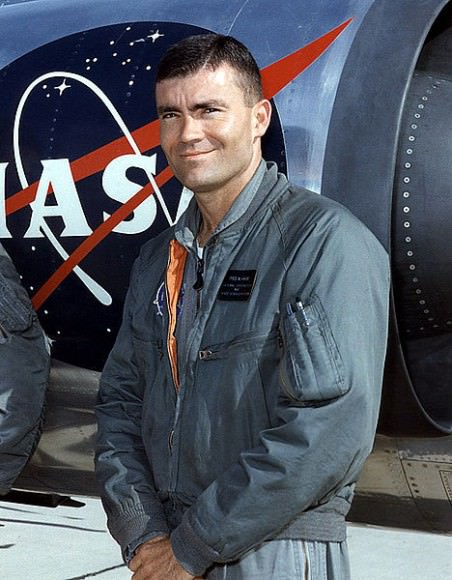
And, equally important, said Woodfill, was the talent Haise brought to recording and rewriting operational procedures. “Fred had been a newspaper stringer for a small newspaper in Mississippi in his youth, taking notes and editing them for his local Mississippi paper’s stories. Utmost among reporters is accuracy in quoting sources. Those transmitted words from mission control had to be flawlessly transcribed if the crew was to survive, and Fred and Jack did an amazing job.
Remarkably, said Woodfill, each man’s talents specifically served the unique need. “Each man exhibited exceptional accuracy in adverse surroundings,” he said. “The lander was noisy, the audio sometimes fuzzy, movement unpredictable, temperatures cold, sleep scarce, and fatigue always present.”
Of course, those familiar with the Apollo 13 story know that Ken Mattingly never got the measles. But the role he played in getting the astronauts back home safely can’t be overestimated.
“Call it luck, call it circumstance,” said Woodfill, “but because of Charlie Duke’s measles the men on board Apollo 13 — and back on the ground — were perfect for the situation they encountered.”
Other articles from the “13 Things That Saved Apollo 13” series:
Part 2: The Hatch That Wouldn’t Close
Part 4: Using the LM for Propulsion
Part 5: Unexplained Shutdown of the Saturn V Center Engine
Part 6: Navigating by Earth’s Terminator
Part 8: The Command Module Wasn’t Severed
Part 12: Lunar Orbit Rendezvous
Part 13: The Mission Operations Team
Also:
Your Questions about Apollo 13 Answered by Jerry Woodfill (Part 1)
More Reader Questions about Apollo 13 Answered by Jerry Woodfill (part 2)
Final Round of Apollo 13 Questions Answered by Jerry Woodfill (part 3)
Never Before Published Images of Apollo 13’s Recovery
Listen to an interview of Jerry Woodfill on the 365 Days of Astronomy podcast.
13 Things That Saved Apollo 13, Part 2: The Hatch That Wouldn’t Close
[/caption]
Note: To celebrate the 40th anniversary of the Apollo 13 mission, for 13 days, Universe Today will feature “13 Things That Saved Apollo 13,” discussing different turning points of the mission with NASA engineer Jerry Woodfill.
When the oxygen tank exploded on the Apollo 13 Command Module, the astronauts on board and everyone in Mission Control had no idea what the problem was. In his book, “Lost Moon,” Apollo 13 commander Jim Lovell thought the “bang-whump-shudder” that shook the spacecraft could have been a rogue meteor hit on the lunar module, Aquarius. Quickly, he told Jack Swigert to “button up” or close the hatch between the Command Module Odyssey, and Aquarius, so that both spacecraft wouldn’t depressurize.
But the hatch wouldn’t close.
Apollo engineer Jerry Woodfill believes the balky hatch was one of the things that helped save the Apollo 13 crew. “They were trying to close off the only way they could save their lives,” he said.
In Mission Control and in the nearby Mission Evaluation Room, several engineers, including Woodfill, thought the only explanation for so many systems to go offline at once was an instrumentation problem. “Initially I thought there was something wrong with the alarm system or the instrumentation,” said Woodfill, who helped develop the alarm system for the Apollo spacecraft. “There was no way so many warning lights could illuminate at once. I was sure I would have some explaining to do about the system.”
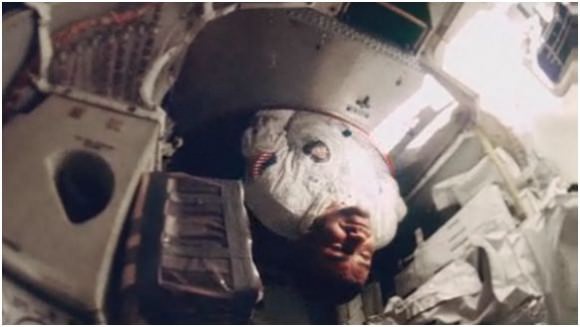
At first, Lovell thought Fred Haise may have been playing a joke on the crew by actuating a relief valve that made a sort of popping noise – something he had done previously during the flight. But with the surprised look on Haise’s face, along with the noise and all the alarms going off, Lovell’s next thought was the hull had been compromised in Aquarius.
Like a submarine crew that closes hatches between compartments after being hit by a torpedo or depth charge, Lovell wanted to close the hatch into the Command Module so all the air didn’t rush out into the vacuum of space.
Swigert quickly tried three times to close the hatch, but couldn’t get it to lock down. Lovell tried twice, and again couldn’t get it to stay closed. But by that time, Lovell thought, if the hull had been compromised, both spacecraft surely would have already depressurized and no such thing was happening. So, the crew set the hatch aside and moved on to looking at the falling gauges on the oxygen tanks.
And shortly after that, Lovell looked out the window and saw a cloud of oxygen venting out into space.
Earlier in the flight, the Apollo 13 crew had opened the hatches between Odyssey and Aquarius, and actually was far ahead on their checklist of preparing to land on the Moon by turning on equipment in the lander.
Woodfill believes this was fortuitous, as was the hatch not closing, because saving time was of the essence in this situation.
“Some people say that doesn’t amount to much time,” Woodfill said, “but I say it did, because if they had closed and latched up the hatch, and then worked to find the real problem of what was wrong, then they would have to delay and quit working the problem to go remove the hatch, stow the hatch and go power up the lander.”
Why was time so important?
The fuel cells that created power for the Command Module were not working without the oxygen from the two tanks. “Tank 2, of course, was gone with the explosion,” said Woodfill,” and the plumbing on Tank 1 was severed, so the oxygen was bleeding off from that tank, as well. Without oxygen you can’t make the fuel cells work, and with both fuel cells gone they know they can’t land on the Moon. And then it became a question of whether they can live.”
But over in Aquarius, all the systems were working perfectly, and it didn’t take long for Mission Control and the crew to realize the lunar module could be used as a lifeboat.
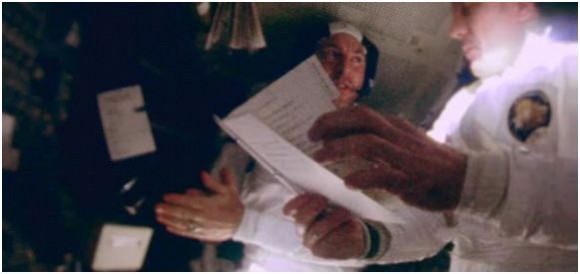
However, all the guidance parameters which would help direct the ailing ship back to Earth were in Odyssey’s computers, and needed to be transferred over to Aquarius. Without power from the fuel cells, they needed to keep the Odyssey alive by using the reentry batteries as an emergency measure. These batteries were designed to be used during reentry when the crew returned to Earth, and were good for just a couple of hours during the time the crew would jettison the Service Module and reenter with only the tiny Command Module capsule.
“Those batteries are not ever supposed to be used until they got ready to reenter the Earth’s atmosphere,” said Woodfill. “If those batteries had been depleted, that would have been one of the worst things that could have happened. The crew worked as quickly as they could to transfer the guidance parameters, but any extra time or problem, and we could have been without those batteries. Those batteries were the only way the crew could have survived reentry. This is my take on it, but the time saved by not having to re-open the hatch helped those emergency batteries have just enough power in them so they could recharge them and reenter.”
It’s interesting when the hatch had to work correctly, when the lander was jettisoned for re-enty, it worked perfectly. But at the time of the explosion, it’s malfunctioning kept the pathway to survival into the LM open, saving time. Being able to get into the lunar lander quickly was what helped save the crew’s life.
Tommorow: Part 3: The measles
Additional articles from the “13 Things That Saved Apollo 13”
series:
Introduction
Part 3: Charlie Duke’s Measles
Part 4: Using the LM for Propulsion
Part 5: Unexplained Shutdown of the Saturn V Center Engine
Part 6: Navigating by Earth’s Terminator
Part 8: The Command Module Wasn’t Severed
Part 12: Lunar Orbit Rendezvous
Part 13: The Mission Operations Team
Also:
Your Questions about Apollo 13 Answered by Jerry Woodfill (Part 1)
More Reader Questions about Apollo 13 Answered by Jerry Woodfill (part 2)
Final Round of Apollo 13 Questions Answered by Jerry Woodfill (part 3)
Never Before Published Images of Apollo 13’s Recovery
Listen to an interview of Jerry Woodfill on the 365 Days of Astronomy podcast.
Astronomy Without A Telescope – Is An Anomalous Anomaly A Normality?
The lack of any flyby anomaly effect when the Rosetta spacecraft passed Earth in November 2009 is what, an anomaly? No. Anomalies arise when there is a mismatch between a predicted and an observed value. When it happens our first thought shouldn’t be that OMG there’s something wrong with physics! We should probably start by reviewing whether we really got the math right.
The flyby anomaly story starts with the Galileo spacecraft‘s flyby of Earth in December 1990 – where it was measured to have gained a speed increase (at least, an increase over the predicted value) of 2.5 millimeters per second at perigee. In its second pass in December 1992, the predicted value was the same as the observed value, although it has been suggested that atmospheric drag effects confound any analysis of this particular flyby.
The next, and biggest anomaly so far detected, was the NEAR spacecraft‘s flyby in 1998 (a whopping 7.2 millimeters per second at perigee increase over the predicted value). After that you have Rosetta showing an anomaly on its first flyby in 2005. Then a quantitative formula which aimed to model the various flybys to date was developed by Anderson et al in 2007 – predicting a small but detectable speed increase would be found in Rosetta’s second fly-by of 13 November 2007. However (or should I say anomalously), no such increase was detected in this, or in Rosetta’s third (2009), pass.
So, on balance, our spacecraft (and often the same spacecraft) are more likely to behave as predicted than to behave anomalously. This reduces (though not negates) the likelihood of the anomaly being anything of substance. One might sagely state that the intermittent absence of an anomaly is not in itself anomalous.
More recently, Mbelek in 2009 has proposed that the anomalous flyby data (including Anderson et al’s formula) can be explained by a more rigorous application of special relativity principles, concluding that ‘spacecraft flybys of heavenly bodies may be viewed as a new test of SR which has proven to be successful near the Earth’. If such recalculated predicted values match observed values in future flybys, that would seem to be that.

Then there’s the Pioneer anomaly. This has no obvious connection with the flyby anomaly, apart from a common use of the word anomaly, which gives us another epistemological maxim – two unrelated anomalies do not one bigger anomaly make.
Between around 20 and 70 AU out from Earth, Pioneer 10 and 11 both showed tiny but unexpected decelerations of around 0.8 nanometers per second2 – although again we are just talking about an observed value that differed from a predicted value.
Some key variables not considered in calculating the original predicted value are radiation pressure from sunlight-heated surfaces, as well as internal radiation generated from the spacecrafts’ own (RTG) power source. A Planetary Society update of an ongoing review of the Pioneer data indicated that revised predicted values now show less discrepancy from the observed values. Again, this doesn’t yet negate the anomaly – but given the trend for more scrutiny equals less discrepancy, it’s fair to say that this anomaly is also becoming less substantial.
Don’t get me wrong, this is all very useful science, teaching us more about how our spacecraft operate out there in the field. I am just suggesting that when faced with a data anomaly perhaps our first reaction should be Doh! rather than OMG!
Astronomy Without A Telescope – Gravity, Schmavity
The axiom that what goes up, must come down doesn’t apply to most places in the universe, which are largely empty space. For most places in the universe, what goes up, just goes up. On Earth, the tendency of upwardly-mobile objects to reverse course in mid-flight and return to the surface is, to say the least, remarkable.
It’s even more remarkable if you go along for the ride.
If you launch in a rocket you will be pushed back into your seat as long as your rockets fire. But as soon as you cut the engines you will experience weightlessness as you arc around and fall back down again, following a similar path that a cannon ball fired up from the Earth’s surface would take. And remarkably, you will continue to experience weightlessness all the way down – even though an external observer will observe your rocket steadily accelerating as it falls.
Now consider a similar chain of events out in the microgravity of space. Fire your rocket engines and you’ll be pushed back into your seat – but as soon as you switch them off, the rocket ship will coast at a constant velocity and you’ll be floating in free fall within it – just like you do when plummeting to your accelerated doom back on Earth.
From your frame of reference – and let’s say you’re blind-folded – you would have some difficulty distinguishing between the experience of following a rocket-blast-initiated parabolic trajectory in a gravity field versus a rocket-blast-initiated straight line trajectory out in the microgravity of space. Well OK, you’ll notice something when you hit the ground in the former case – but you get the idea.
So there is good reason to be cautious about referring to the force of gravity. It’s not like an invisible elastic band that will pull you back down as soon as you shut off your engines. If you were blindfolded, with your engines shut off, it would seem as if you were just coasting along in a straight line – although an external observer in a different frame of reference would see your ship turn about and then accelerate down to the ground.
So how do we account for the acceleration that you the pilot can’t feel?
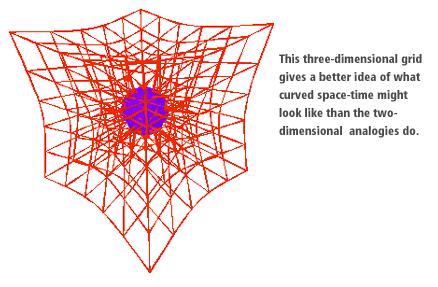
Without a blindfold, you the pilot might find the experience of falling in a gravity field a bit like progressing through a slow motion movie – where each frame you move through is running at a slightly slower rate than the last one and where the spatial dimensions of each frame progressively shrink. As you move frame by frame – each time taking with you the initial conditions of the previous frame, your initially constant velocity becomes faster and faster, relative to each successive frame you move through – even though from your perspective you are maintaining a constant velocity.
So – no force of gravity, it’s just geometry.
Astronomy Without A Telescope – The Only Way Is Up
Escaping a gravity well is never an easy proposition. Unlike other kinds of wells there are no walls, so your options are ilimited. Over the years we humans have experimented with a variety of ways of getting out – with varying levels of success.
Trying to build your way out was first attempted – at least allegorically – with the Tower of Babel which (again allegorically) did not go well. Even with today’s engineering, it remains a dubious prospect. The relatively new Burj Khalifa in Dubai has managed to scale only 830 metres. The official defintition of where ‘space’ starts is 100 kilometres (or 60 miles).
Firing yourself out of a cannon or strapping explosives to your throne in the case of Wàn Hù, generally described as a minor official of the Ming Dynasty circa 1500, is similarly fraught with problems. See the Mythbusters episode Ming Dynasty Astronaut to see how that worked out.
Even if you do survive the initial blast, the huge acceleration required to achieve a projectile escape velocity of 11.2 kilometers a second from sea level will kill you anyway. And there’s also an issue of atmospheric drag – since the air in front of you will be superheated, your already Gforce-demised self will get cremated on the way up.
It would all be so much easier if someone could just throw down a rope. Various people have been attributed with first thinking up the space elevator – but it was probably Konstantin Tsiolkovsky – involving getting a base station into geostationary orbit and then lowering down from it kilometre-lengths of a carbon nanotube cable that we’ll be inventing any day now.
So for the moment at least, we are stuck with good old-fashioned rockets – for which we can also thank Mr Tsiolkovsky, amongst others. Although achieving a zero to 11.2 kilometers a second velocity at sea level will kill you – if you can get a bit of altitude at a lower acceleration rate, the escape velocity from that altitude will be lower. So as long as you can launch with enough fuel to keep gaining altitude, you can keep on applying this logic until you eventually escape the gravity well. We’ve done it with robotic spacecraft, but we’ve never done it with people.
Before I start sounding like a Moon landing denier, remember the Moon is still orbiting within Earth’s gravity well. Lagrange points 1 and 2, about 1.5 million kilometres away mark the edges of the Earth’s gravity well. L2 is perhaps the better target since you could use the Earth’s shadow to reduce your exposure to solar radiation. At 1.5 million kilometers, it’s about four times the distance to the Moon, so a one month round trip maybe. It’s still challenging and you’ll still collect a hit from cosmic rays – but nothing like the potentially suicidal two year round trip to Mars. So, if we can get past this obsession with landing on things, wouldn’t it be a wothwhile goal to try and finally get someone out of the well?
Best Description Ever of How to Go to the Bathroom in Space
Astronauts say it is the most-asked question they get from people. There have been books written about it. Maybe because we all have to do it, everyone wants to know how it works in zero-gravity. This past weekend I gave a presentation to about 60 Girl Scouts about living and working in space, and I knew this question was going to come up. It did, and with this video, I was prepared. Here, Canadian astronaut Chris Hadfield eloquently gives the best description ever of how it works to go to the bathroom in space. And he tells all in less than two minutes, too.
ISS Temporarily Down to Crew of 2
Following today’s departure of the three man crew of Expedition 21 aboard the Soyuz TMA 15 capsule, staffing on the International Space Station (ISS) is now temporarily reduced to a skeleton crew of just 2 men for the first time since July 2006. The ISS had hosted a complete 6 person and truly international crew complement for the first time ever since its inception, starting in May of this year.
Soyuz Commander Roman Romanenko (Russia), European Space Agency Flight Engineer Frank De Winne (Belgium) and Canadian Space Agency Flight Engineer Bob Thirsk floated into their three segment Soyuz return capsule on Monday evening, Nov 30. After powering up systems and a farewell ceremony the hatches were closed at 7:43 PM EST. They disengaged hooks and latches and then physically undocked from the Zarya module at 10:56 PM over Mongolia after spending 188 days in space. De Winne was the first European commander of the ISS. All prior commanders have been either Russian or American. Romanenko is a second generation cosmonaut. His father Yuri, flew his first mission in 1980. Thirsk is the first long duration Canadian astronaut.
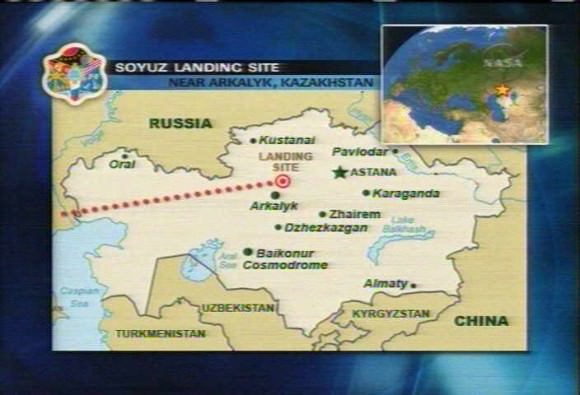
Retro rockets were fired for 4 min 19 sec at 1:26 AM Tuesday morning to initiate the de-orbit braking maneuver for the fiery plunge of atmospheric reentry. 19 minutes later the three Soyuz segments pyrotechnically separated at an altitude of 87 miles. The Soyuz barreled backwards as it hit the earth’s atmosphere at 400,000 ft above Africa and the crew experienced maximum G forces. The three parachuted to a safe touchdown strapped inside their Soyuz descent module onto the snowy steppes of Kazakhstan at 2:15 AM Tuesday Dec 1 (1:15 PM Kazakhstan local time) thereby concluding a mission that began with a May 27 blast off. Russian search and recovery forces drove to the ice cold landing zone at Arkalyk to greet and assist the trio in opening the hatch, exiting the craft, readapting to earth’s gravity and returning to Star City. This was the first December landing of a Soyuz since 1990.
Poor icy weather and low clouds grounded the normal recovery force of 8 helicopters. The capsule landed right on target and in an upright configuration. Recovery forces sped quickly into place. Romanenko was first to depart out the top hatch of the capsule, followed by Thirsk and De Winne. They were carefully extracted by the ground based recovery team and immediately assisted into stretchers while smiling broadly and waving to the crowd. Then they were swiftly slid into all terrain vehicles larger than their capsule for the initial leg of the ride back to Russia. Flight surgeons confirmed the health of the crew who are eager to re-unite with family and friends and earthly comforts.
The Expedition 22 core crew of NASA Commander Jeff Williams and Russian Flight Engineer Max Suraev remain as the sole two occupants for about three weeks until the Dec 23 arrival of the next international crew comprising Russian cosmonaut Oleg Kotov, NASA’s T.J. Creamer, and Soichi Noguchi of the Japan Aerospace Exploration Agency who head to the station Dec. 20 on the Soyuz TMA-17 craft from the Baikonur Cosmodrome. Williams and Suraev arrived by Soyuz capsule TMA -16 in October.
US astronaut Nicolle Stott rounded out the six person ISS crew until her departure just days ago on Nov 25 aboard shuttle Atlantis (link) left just five people on board. She spent 91 days aloft conducting science experiments and has the distinction of being the last ISS resident to hitch a ride up and down on a shuttle. Future crew rotations are planned via Russian Soyuz rockets since the shuttle will be retired by late 2010 and NASA’s Ares / Orion launch system won’t debut until 2015 or later.
Watch video of the shuttle “belly flip” as it arrives at the station.
During 7 days of joint operations in late November, the ISS boasted an ethnically diverse population of 12 humans from the combined crews of STS 129 Atlantis and the resident ISS members from two docked Soyuz capsules, just shy of the record 13 occupants. With all the comings and goings of assorted manned and robotic spaceships lately it’s been an exceptionally busy time that required careful planning and traffic coordination among the world’s space agencies.
The 800,000 pound station is now 86% complete and thus far larger and more complex compared to the last instance of a two person contingent. Since the 2005 Return to Flight of the shuttle following the Columbia accident, several habitable modules (Harmony, Columbus, Kibo, Poisk), truss segments, radiators, stowage platforms and giant solar arrays have been attached. All this has vastly expanded the astronauts and cosmonauts daily responsibilities of both maintaining station systems and carrying out a much expanded scientific research program.
Bill Gerstenmaier, NASA’s chief of space operations, said the ISS partners have carefully looked at the operational challenges of this three week interlude to make sure “there is not a lot of activity going on then, other than some software uploads. We moved all the major activities that were occurring to other periods when there will be more crew. We are prepared and ready to cut back a little on operations but still be able to do a little bit of science research with just two crew members on orbit.”
Three space walks by the Atlantis crew helped pave the way for the next shuttle ISS assembly flight in February 2010, designated STS 130, which will haul up the long awaited Tranquility and Cupola modules and which I recently observed close up at the ESA to NASA hand off ceremony inside the Space Station Processing Facility (link) (SSPF) at the Kennedy Space Center.
Atlantis delivered two large pallets loaded with 15 tons of critical spare parts that will help extend the working lifetime of the ISS and serve as a hedge against on orbit equipment failures ahead of the fast approaching deadline when the space shuttle is no longer available to loft such bulky gear.
Only 5 flights remain until the shuttle era ends late in 2010. The Orion capsule will not debut for at least five years and perhaps longer, dependent on funding decisions in Washington, DC. The station will then be completely dependent for supplies and equipment on Russian, European and Japanese cargo vehicles. Test flights of US commercial ISS transport vessels begin next year.
Not until another three person Soyuz blasts off next April 2010, will the station return to a full team of six. But science research will be full speed ahead.
Amazing Images from STS-129
If I didn’t know better, I’d swear some of the images from the STS-129 shuttle mission to the International Space Station were CGI renderings taken from a science fiction novel. Take the above image, for example of astronaut Mike Foreman working on the exterior of the ISS during the second space walk of the mission. It looks almost surreal. But these are genuine images of real people working on an authentic, almost-completed space station. This images, and the other images below, leave me in awe of what we are accomplishing in space. Enjoy this gallery of amazing images from the fifth and last shuttle flight of 2009.
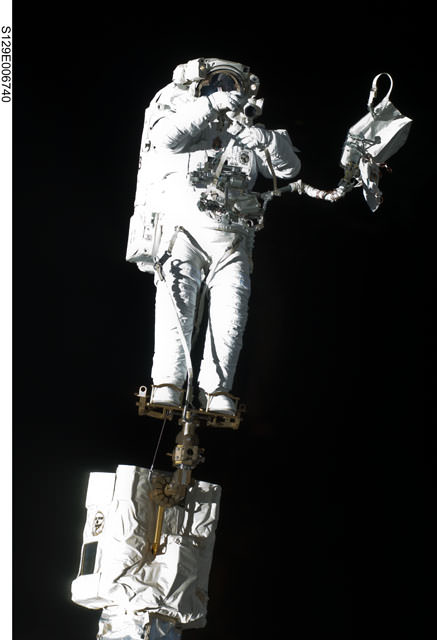
Here’s another awe-inspiring image. Anchored to a Canadarm2 mobile foot restraint, astronaut Robert Satcher Jr. works during the first space walk of the mission. Satcher and Mike Foreman (out of frame)installed antennas, cables, and other items to prepare for the Tranquility node that will be brought up to the station next year.
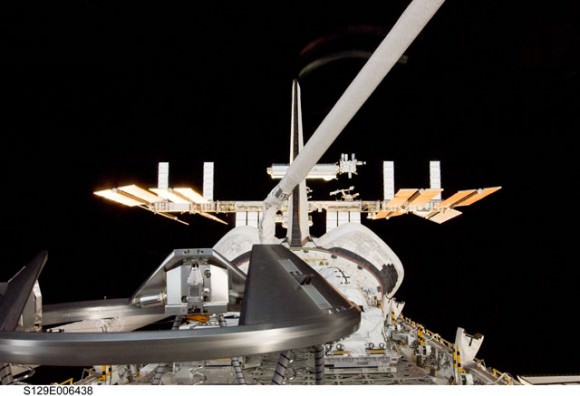
There was some chatter on Twitter that this image brought to mind visions of the Starship Enterprise from Star Trek. But this is a closeup of Atlantis’ docking ring backdropped by the ISS as the shuttle crew approached for docking with the station. Docking occurred at 10:51 a.m. (CST) on Nov. 18, 2009.
Another great shot: Sunrise in space. This scene shows from the Russian section of the ISS, as photographed by one of the STS-129 crew members.
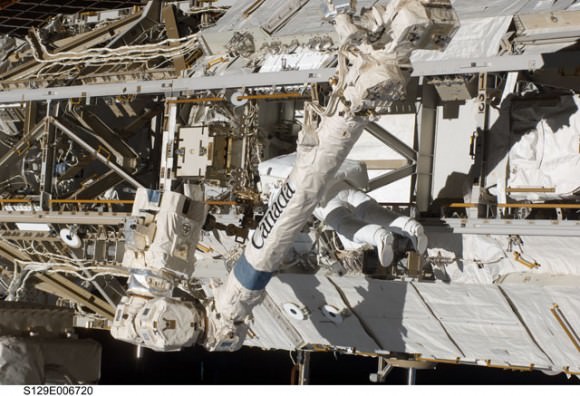
I always love these images which demonstrate how HUGE the ISS is. Here, Robert Satcher works on the Z1 truss section during the first EVA of the mission.
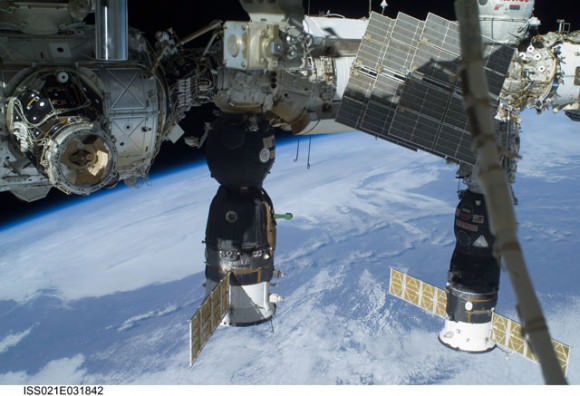
Taking on the appearance of a busy spaceport, the Russian segment of the ISS has a docked Soyuz spacecraft (center) and a Progress resupply vehicle that is docked to the Pirs Docking Compartment.
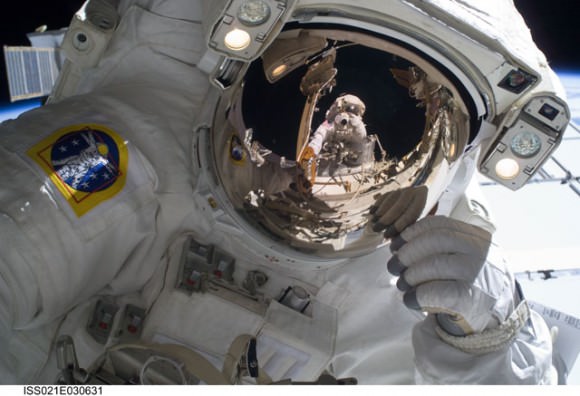
Every shuttle mission picture gallery isn’t complete without a picture of an astronaut with another astronaut visible in the helmet visor reflection. Here, Mike Foreman’s helmet reveals his crewmate, Randy Bresnik, capturing the image with an electronic still camera. The two were in the midst of the second scheduled space walk for the Atlantis crewmembers.
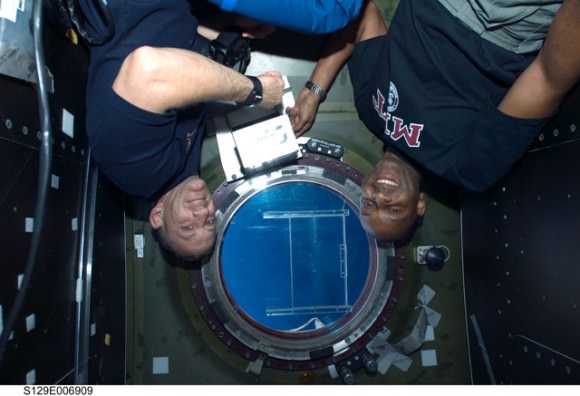
Who is upside down? Charlie Hobaugh (left), STS-129 commander and Robert Satcher , or the astronaut who took the picture? The two are pictured near a window in the Destiny laboratory.
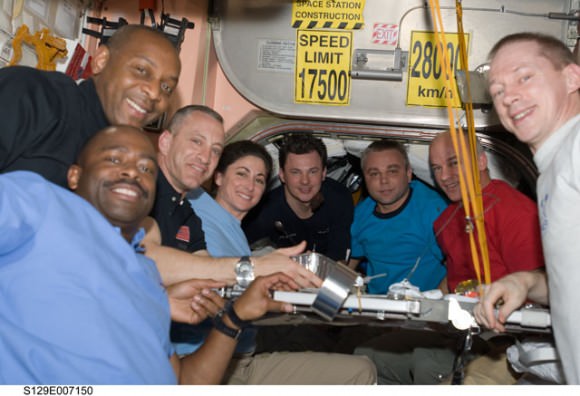
Eight of the 12 crew members of the joint ISS/shuttle crews pose for a photo at the galley in the Unity node. Pictured from the left are NASA astronauts Leland Melvin, Robert Satcher Jr., Charlie Hobaugh, Nicole Stott, cosmonauts Roman Romanenko, Maxim Suraev, and astronauts Jeff Williams, and Frank De Winne, commander of Expedition 21 from the ESA.
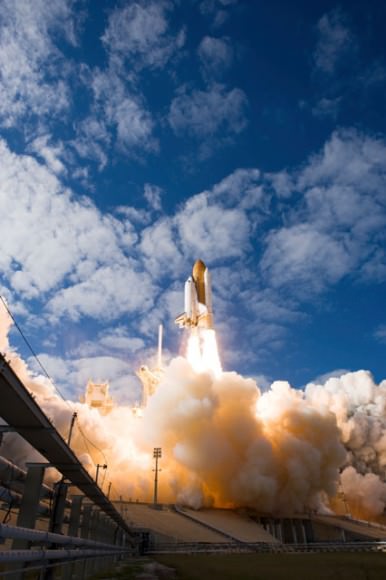
A gorgeous shot of Atlantis’ launch on Nov. 16. Below is another launch picture, with the members of the NASA Tweetup watching by the famous countdown clock.
